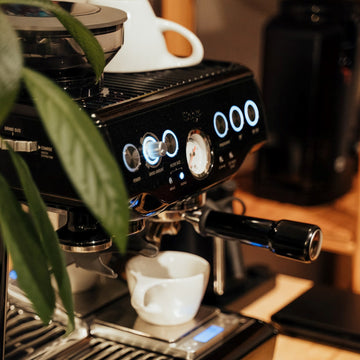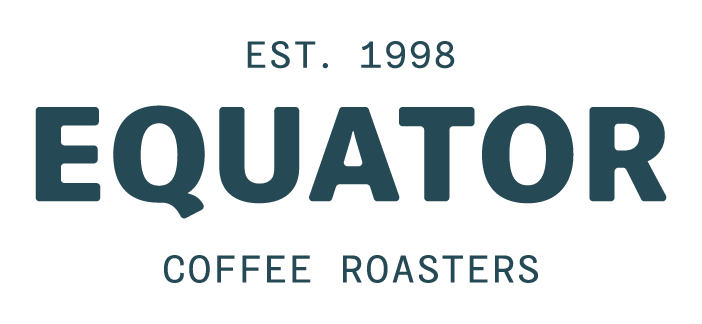
Are you looking to make improvements to your home coffee set-up but don’t know where to begin? There are many products on the market that claim to make the perfect cup, but which is best for you and your lifestyle? We wish to offer you our expert, unbiased recommendations on brewing equipment and accessories to make your coffee at home taste as good as it would in our cafés.

We will begin by covering a more advanced but increasingly popular brewer - the domestic espresso machine. Purchasing an espresso machine can be daunting, which is fair since as you start shopping around, you will quickly realize that their prices can range from the hundreds to the thousands.
When helping a customer choose an espresso machine for at home, Chris always asks:
- Budget - how much are you willing to invest in owning an espresso machine, the accessories, the service, and the coffee you wish to run through it?
- How many cups a day do you plan on making?
- How serious are you about brewing the perfect cup of espresso? Is owning an espresso merely a convenient luxury or a passion to learn and enjoy the process?
Once you have figured out where you stand in terms of budget, frequency of use, and the importance of the quality of the machine you purchase, it’s time to pick out a brewer. These are Chris’s recommendations for budget, mid-range, and high-end domestic espresso machines.
If you’re looking for an accessible, budget-friendly, beginner espresso machine, look no further than the Breville Bambino plus. It is compact, user-friendly, and heats up quickly. The Breville Bambino plus is also a great little showpiece on your countertop!
The Rancillio Silva is an entry-level commercial-style espresso machine, with a compact design and small footprint on your countertop. While it may not be quite as stylish as some other models on the market, this machine is dependable and pulls a great shot of espresso.
And at the very top-of-the-line, the Rocket R58 comes adorned with all the bells and whistles. With this machine (as well as some practice and skill) you will be able to easily replicate the espresso you drink from your favorite café.
More often than not, espresso machines will not be ready to go right out of the box. You will also need to purchase a collection of accessories that are necessary in the ease of use of your machine and getting a great espresso every time.
Grinder
The first thing you will need is a grinder. No matter how you brew your coffee, grinding it fresh is the most simple and effective way to ensure you are getting a great cup. The importance of the grinder cannot be overlooked, Baratza, Mazzer, Mahlkonig all make great espresso grinders starting around $600. In order to get a consistent grind size, and a machine that will last and is easily serviceable you need to invest in your grinder. You will never regret spending too much on a grinder, but you will regret not spending enough.
Scale and timer
These are the necessary tools in dialling in your grinder and coffee dosage to get a consistent great-tasting cup. If you skip this, you risk extracting espresso that is either harsh and bitter or overly acidic. To achieve brewing espresso that is silky and sweet, a scale and timer are necessary tools.
Tamp mat and knock box
A knock box is a box with a hole on the top and a rubber edge designer for tapping (or knocking) the spent espresso grounds out of the basket and into the waste bin. While some may argue these items are for show, we are here to tell you that hitting our portafilter on the side of your smelly garbage is gross. A knock box not only protects your portafilter and saves you from retrieving the basket from the garbage from time to time, they are also an inexpensive way to improve your coffee set-up and keep it sanitary. The same is true for the tamp mat. This protects your counter and portafilter and gives you an even surface to tamp your espresso.
A good quality tamper
A tamper is a heavy, smooth, weight that fits in the palm of your hand, and with a small amount of pressure, flattens and smooths the surface of the coffee grounds in the basket of the portafilter before brewing. This ensures that the water has a smooth surface to extract from and doesn’t create a funnel. Some espresso machines will come with a tamper, but most of the time we would recommend an upgrade. The most important consideration is to find a tamper that perfectly fits your basket. The industry standard is 58.5 millimeters. Find something that feels good in your hand, has a solid amount of weight, and properly fits your basket and you will be in good shape.
Cups
A common oversight, but like nice wine and beer, having the right cup for the job is crucial to a great coffee drinking experience. This can range from a small 3 oz espresso cup and saucer, to a larger 8 oz or 10 oz cup for a cappuccino or latte.
EVO and cloths
Ensure you have EVO (a special cleaner that’s safe for coffee machines) and clean cloths on hand to keep your machine in tip-top condition. Not only will this keep it clean and sanitary, it will make your machine last longer and produce better tasting coffee.
The right coffee!
While this may seem obvious, a great espresso machine cannot fix a bad coffee and vice-versa. Choose a coffee you love and experiment with new coffees. Not only is this fun, but trying new coffees refines your palate and makes you an even better home barista.
Espresso should be smooth, sweet, pleasantly acidic, and bitter with a frothy head called the crema. To achieve this, an espresso machine uses a balance of heat and pressure to extract a small amount of strong coffee from finely ground beans. Once you have your espresso machine, dial in your grind-size using your grinder, a scale, and a timer.
- Starting with the recipe provided by the coffee roaster, weigh out the suggested amount of coffee beans.
- Grind the beans finely using a burr grinder.
- Pour the ground coffee into the basket. Flatten the grounds with your hand, tamp, and secure the portafilter to the espresso machine.
- Place the scale under the brew head and your cup on the scale.
- At the same time, start your espresso machine and timer.
- The espresso should ‘pull’ a full shot in the recommended amount of time. Refer to the recipe for brew time and ‘wet weight’ and compare that to your timer and scale.
- If the shot pulls too slowly, you need a coarser grind and if it finishes pulling too quickly, you need a finer grind.
- North Star Espresso -
Dry weight: 19g of finely ground North Star
Wet weight: 30-34g of espresso
Duration: 25 - 30 seconds
More questions? Email Chris directly at chris@equator.ca
To get notified when we publish new blog posts like this, subscribe to our newsletter!



